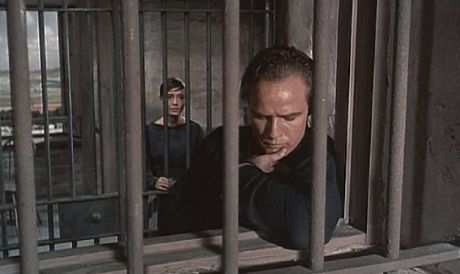The spirit of submission and acquiesence lives in a Home Theatre Forum thread about the restored One-Eyed Jacks. Some of the commenters seem to recognize that the decision by Universal and the Film Foundation to slice off the tops and bottoms of Marlon Brando and Charles Lang‘s 1961 classic in order to render a 1.85 aspect ratio wasn’t necessary, and yet their attitude is more or less “whatever…we don’t mind!” A couple of commenters seem to believe that my opposition to this decision is based upon delusion or ignorance. In fact they’re the ones wearing blinders.

Let’s try again. One-Eyed Jacks was shot in the “flexible and compatible” VistaVision process and therefore could have easily been cropped at 1.66, 1.75 or 1.78. But no. In order to conform to a currently meaningless and completely political, consensus-driven suggestion contained in a Paramount memo back in the late ’50s (or whenever) that Jacks should be projected at 1.85, Uni/FF decided to follow suit.
This is not a tragedy — Jacks will look beautiful at almost any a.r. — but it’s certainly cause for lamenting. As I noted on 4.26, archivist Bob Furmanek is probably a chief culprit in this affair. By submitting and endorsing the Paramount suggestion, he relieved Uni/FF of any creative responsibility in determining the aspect ratio of the One-Eyed Jacks Bluray.
On page 10 of the HTF thread, some guy named “Billy Batson” says “it should be noted that those thin black lines [that are used to present a cropped 1.85 a.r. on the Bluray] are put over picture information. I don’t know why they bother but, as I’ve said, I don’t mind either way.”
Are you hearing this guy? Luscious, carefully lighted visual information that wouldn’t have compromised the artistic integrity of One-Eyed Jacks by a single iota and would have doubtlessly enhanced it has been blacked out or redacted, and this slug says “I don’t mind”! Is there anything more contemptible than an alleged film lover who doesn’t care when movies are cropped for no reason other than indifference or deference to documentation on the part of restorationists?
In response to Batson, some bozo named Stephen_J_H writes “true, but that information was never intended to be seen, contrary to Jeffrey Wells’ assertions.”
I guess I need to repeat this again. Paramount acknowledged in that 50something-year-old memo quoted by Furmanek that VistaVision is “flexible and compatible” and was therefore screenable in any number of formats. If it’s screenable in formats taller or boxier than 1.85 then I guess “that information” was intended to be seen, depending on the circumstances (some hinterland projectionist deciding to use a 1.66 aperture plate rather than 1.85, broadcast television, etc.).
“I suppose [Wells] would want E.T. in 1.37:1,” this guy continues, “except that if he bothered to read anything, he’d know that dp Allen Daviau composed the film loosely for 1.75:1 and shot with a 1.66:1 hard matte in-camera.” Huh — I’ve never heard about a 1.66:1 hard matte version. The DVDs and Blurays of E.T. have always been either 1.78 or 1.85.
The thread includes a statement by Roger Ebert in favor of letterboxing: “My opinion is that (a) anyone who actually works in a video store and does not understand letterboxing has given up on life, and (b) any customer who prefers to have the sides of a movie hacked off should not be licensed to operate a video player.”
HE version: “Anyone who claims to love ’50s and ’60s era cinematography needs to understand that whacking off the tops and bottoms of perfectly good VistaVision-shot films is pointless (certainly in terms of preferring 1.85 to 1.78, 1.75 or 1.66) and pretty close to reprehensible, and (b) any customer who prefers to watch films that have been cropped for what are essentially political reasons (i.e., in the ’50s because industry consensus demanded a uniform 1.85 a.r. outside of Scope films, and today because it’s less risky to favor an a.r. that some Paramount flunky suggested adherence to because everyone else was doing it) should not be licensed to operate a Bluray player.”
